Fear and Loathing In Las Vegas (1998)
Directed by: Terry Gilliam
Written by: Alex Cox, Terry Gilliam, Tod Davies, Tony Grisoni
Starring: Benicio Del Toro, Cameron Diaz, Christina Ricci, Johnny Depp, Tobey Maguire
USA
AVAILABLE ON BLU-RAY from ARROW VIDEO
RUNNING TIME: 118 mins
REVIEWED BY: Dr Lenera, Official HCF Critic
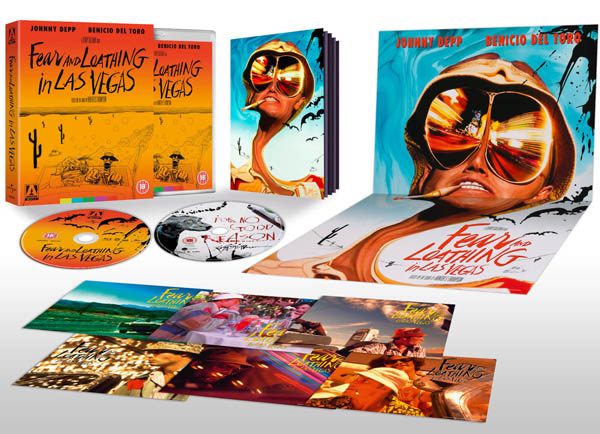
It’s 1971, and journalist Raoul Duke has been assigned by a magazine to travel to Las Vegas and cover the Mint 400 motorcycle race. He’s accompanied by his slightly unhinged Samoan attorney, Dr. Gonzo, and a trunk load of drugs. After scaring off a hitchhiker, the two rush to the city before the guy can go to the police, but Duke barely makes it through check-in due to being on acid. Though they get their press credentials and a comped room, Duke’s job is rarely on the forefront of his mind. Running up room service bills and damages, the two friends wander around both the town and the emotional spectrum.…
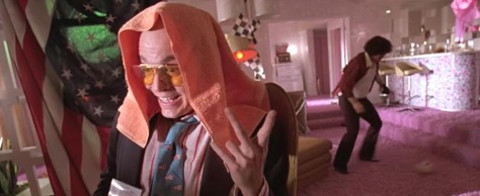
Whilst watching Fear And Loathing In Las Vegas on its stonking new Blu-ray release from Arrow Films, the thought came to me that, if it had been made back in the early ‘70s soon after Hunter S. Thompson had written his novel of the same name, it would have seemed incredibly timely and may have made an impact almost as great as Easy Rider. Oddly enough this was one Terry Gilliam film that I didn’t take to in the cinema, despite me having been a huge fan of this filmmaker for some time, and counting Brazil as one of my top five favourite films of all time. It seemed an unusual movie for Gilliam to make, seeing as he’s said on many occasions that he’s had very little experience of drugs, and also that it deals with a time and place that was more immediate than any of his previous films [think about it, even The Fisher King, despite making good use of New York, could basically have been set almost anywhere] And it seemed to me to be a rather pointless exercise – I mean many of us have our benders from time to time, but watching other people getting off their heads has rarely struck me as a particularly fulfilling thing. But on a second viewing on video I not only totally got into its very darkly comic, not unintelligent madness [ think a Cheech and Chong movie made by Frederico Fellini] but it suddenly struck me a while into it what it was, in part. Well, for a few minutes until I wondered if I was reading to much into it, before a scene thankfully came along that explicitly stated what I had been thinking; this was set in a time when the hippie movement had evaporated into disillusionment and its mass drug taking had not resulted in peace, love and a brave new world but exploitation, paranoia and anger. And what better place to put two casualties of the counterculture culture than Las Vegas with its gaudy tackiness, the ultimate symbol of the consumerist America they wanted to get rid of?
Ralph Bakshi [whose animated version would have been in the style of Ralph Steadman’s illustrations for the book], Martin Scorsese [with Dan Akroyd and John Belushi] and Oliver Stone all tried and failed to set up a film of this supposedly unfilmable novel. Then Rhino Films began work on a version in 1992 with a script by Alex Cox and Tod Davies, but Lee Tamahori and Bruce Robinson both proved unavailable to direct. With the rights running out, Rhino hired Gilliam, and Thompson granted an extension of the rights with the stipulation that Gilliam direct and the Cox/Davies script not be used, and after Thompson met with Johnny Depp he became convinced that no one else could play him. However, Rhino still wanted to film the Cox/Davies script with Cox directing and without Depp and Benicio del Toro. Universal Pictures then stepped in as distributors, and Gilliam and Tony Grisoni hammered out a new script in ten days, but the director still didn’t have a firm deal in place, so Depp and Gilliam locked Rhino’s executives out of the set during filming. Depp moved into the basement of Thompson’s home and lived there for four months, doing research for the role as well as studying Thompson’s habits and mannerisms, while Del Toro gained more than 45 pounds in nine weeks before filming began, eating 16 donuts a day. Depp even wore some of Thompson’s old clothes for the film. The low budget shoot was unsurprisingly chaotic though Gilliam enjoyed it more than many of his others due to there being no studio interference. But then came a row with the Writer’s Guild of America who wanted to deny Gilliam and Grisoni writing credit and have the names of Cox and Davies up instead. At a test screening, Thompson yelled stuff out and jumped on his seat, apparently reliving his old trip. The film was a minor commercial failure and heavily divided critics, but quickly became one of the major cult movies of the ’90s.
So we first meet Raoul, whom Thompson based on himself, and his lawyer Dr. Gonzo, based on Thompson’s actual lawyer Oscar Zeta Acosta who disappeared in 1974, on their way to Las Vegas to cover this motorbike race, and in fact the first ten minutes are virtually a microcosm of the rest of the film, it’s all here. Duke is already whacked out on mescaline and starts seeing bats which he tries to ward off with a spatula. Then the two pick up a hitchhiker, played by Tobey Maguire in the first of a whole series of memorable cameos, one of them being Thompson himself when a very high Duke sees “himself” in a 1965 flashback. The behaviour of both Duke and Gonzo is intimidating and the poor guy jumps out of their car. Already, we’re shown that the constant drug taking of these two makes them rather worse as people, especially Gonzo, as negative emotions take hold. And already this makes a mockery of those who claim that the film advocates drug use. It doesn’t exactly yell at us that Drugs Are Bad, preferring to say that, yes, these two take drugs as a lot of people still do today, and often get enjoyment out of it, but it also shows us that the results aren’t always pretty. Maybe this film actually required a director like Gilliam, no not a drug user but hardly the sort of person to criticise those who are and to present us with lots of Big Warnings, to provide a balanced view. I also think that one of the things I didn’t initially like is that Duke and Gonzo don’t appear to be especially nice people. Gonzo seems borderline psychotic! But of course such things make a film more fascinating as one gets older. Seeing the unpleasant way that these two behave towards others, especially Gonzo who sometimes seems like he’s about to kill someone with that knife of his he keeps waving around, one is struck by the idea that it wouldn’t take much to turn this into a full-on horror movie about two drug-crazed lunatics who terrorise and maybe even murder folk on a rampage through Las Vegas.
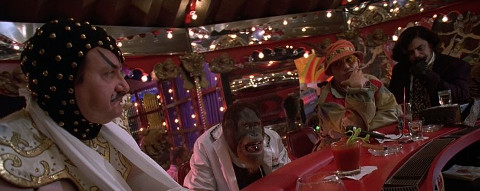
The city is often portrayed by footage taken from a documentary, back projected as our two reprobates drive through it, but in this particular movie the device can hardly be said to be out of place. By the time Duke and Gonzo reach the strip, Duke is in the middle of an acid trip and barely makes it through check-in, while hallucinating that the carpet is rippling, blood is pouring over the floor, and that he “was right in the middle of a f****** reptile zoo, and somebody was giving booze to these goddamn things”, the idea of lounge lizards taken to its logical extreme. The next day, Duke, in his own words the “absolute cream of the national sporting press”, arrives at the race and heads out with his photographer, Lacerda, but thinks that they’re in the middle of a battlefield, so he fires Lacerda and returns to the hotel. Despite Las Vegas clearly not being a good place to take psychedelics, more substances are ingested, the drugs almost a tool for comprehending the horrifying garishness of the place which can match any weirdness or horror caused by something you’ve just taken. At one point Gonzo leaves, and then Duke does the same, but returns to Vegas when he’s told that he’s been assigned to cover a district attorney’s convention on narcotics and dangerous drugs – which of course he needs cocaine to get through. It’s possible that he’d get through his hazy days reasonably well if it wasn’t for Gonzo who, when he isn’t wandering off, is a coiled spring, threatening interviewers [look out for Cameron Diaz], hotel maids in perhaps the film’s most brilliant mixing of threat and humour as they convince the poor woman that they’re police officers investigating a drug ring, and even Duke himself. The only time he seems content is when he’s hooked up with an underage girl who paints pictures of Barbara Streisand.
There’s little plot, but there’s some balance to the narrative as events keep recalling previous ones. The pacing is rather erratic, and some scenes don’t catch fire the way they should, but there’s so much else that often gets funnier with each watch, like Nick Nolte’s cameo as a “lonely” cop, and Duke and another guy [Flea from the Red Hot Chili Peppers] caught taking acid by a yuppie, to which Depp’s narration, which is sharp and amusing throughout and often taken from the book, concludes, “With a bit of luck, his life was ruined forever. Always thinking that just behind some narrow door in all of his favourite bars, men in red woolen shirts are getting incredible kicks from things he’ll never know”. Depp is hilarious to watch, and it’s a shame that this [just watch him at the fairground], and Benny And Joon showed a gift for physical comedy of the really old school that was never properly followed through. He’s perfectly balanced by Del Toro who seems always on the verge of doing something totally spontaneous. As for Gilliam, his film has the attitude and vibrancy of the work of a young filmmaker, out to make a mark and shake things up, rather than something made by a 58 year old. And there’s a scene near the end in a cafe that’s so powerfully uncomfortable – without having any physical violence – that it makes me wish Gilliam would direct a really dark, cruel yet also very realistic movie [though I guess the largely misunderstood Tideland came close]. Despite the subject matter, he does somewhat restrain his penchant for visual flights of fancy – there are some, but he and cinematographer Nicola Pecorini mostly prefer to give an impression of the drug experience through cinematic techniques such as very soft depth of field, strange colour schemes [often Duke and Gonzo are bathed in a different colour to what’s around them], and a camera that never stops swaying. Many scenes of the two wandering about while off their heads play for extended lengths without much cutting; the choreography is superb. Gilliam is still so hugely underrated.
Duke and Gonzo may not behave very intelligently, but their exploits are chronicled with a clever eye which is also perceptive on the issue of psychedelic drugs without ramming stuff down you. Many folk who delve into psychedelics do so because they’re seeking some hidden truth about life, the universe and everything, and initially often catch glimpses of this truth which makes them dabble even more. However, said truth more often than not turns out to be something you barely remember amidst a whole load of crazy shit you may have done while in another dimension – and then there’s the return to this dimension, the hangover, which just gets worse and worse the deeper you delve, something symbolised by that ugly cafe scene which takes place about as far away from the archetypal Las Vegas glitz as you can imagine, and interestingly a scene that didn’t exist in any versions of the script until Gilliam and Grisoni’s. It’s really rather poignant the way its two protagonists still seem to cling to the hippie dream of altered states being the way towards a better world, not realising that said dream is over and that the reality of what was already becoming a rather confused, grim new decade needs to be confronted. But Fear And Loathing In Las Vegas in also just plain fun if your taste leans towards the offbeat, not least because there isn’t really a film like it, something which may go some way to explaining why it’s one drug movie that’s liked by many who’ve stayed clean, including HCF’s webmistress Bat who wanted to amend her earlier review for this release but didn’t have the time. And, despite the period in which it’s set, it’s still pretty relevant today in a way. The world seems to be getting madder, and sometimes the only appropriate response seems to be to go bonkers yourself for a while.
Rating: 









I own the 2003 Criterion DVD release of this film, though not the subsequent Blu-rays from Universal [which had no extras besides deleted scenes] and Criterion [which ported over everything from the DVD]. I did always felt that the film looked a bit older than it actually was on that DVD [if that makes sense]. Therefore watching Arrow’s new restoration was almost like watching Fear And Loathing In Las Vegas for the first time for me. It looks magnificent, even during the many scenes with odd and changing colour schemes. Grain is well managed, edges are sharp, blacks don’t bleed – I couldn’t find even a minor fault with the picture quality. Excellent.
The Criterion disc was pretty comprehensive but Arrow’s just about outdoes it. As with their release of Robocop, they’ve put together a very comprehensive package which ports over many old special features and adds quite a few new ones. Now unlike Robocop there’s only one audio commentary, so fans may want to hang on to the Criterion seeing as it contains three commentaries where we here from Gilliam, Depp, De Toro, producer Laila Nabulsi and even Thompson himself. It’s been a long time since I’ve listened to those, but it’s always good to hear from Gilliam again as his honest, intelligent yet often amusing tracks never fail to deliver. Here, he may say at the beginning that he’s “an old man teetering on the edge of the abyss”, but he rarely shuts up, the track not really needing moderator Phil Stubbs, though he asks all the right questions. Gilliam gives out lots of tidbits like the car in the film being Thompson’s which Depp stole from him, likens the film to the Divine Comedy [and therefore explains that angel near the beginning], calls Thompson “an irritating human being” despite his admiration of him, points out when improvisation was done, and is clearly proud of the film. He’s still great.
Next are the four new featurettes. Ian Christie wrote, with Gilliam, the wonderful Gilliam On Gilliam book, so Savage: Finding The American Nightmare was always going to be enlightening. He mentions how there’s an air of innocence in Duke and Gonzo’s antics, how following his previous two films The Fisher King and Twelve Monkeys he was able go full on and “take apart and reconstruct in his own image” this project, and how it’s one of the two great Las Vegas movies. The Gonzo Papers has producer and Thompson’s emissary during production Laila Nabulsi discuss the production and tell us that she worked with Del Toro on the script before giving it to Gilliam, how Universal would have mutilated it if Gilliam hadn’t have had final cut, and how the disastrous reception at Cannes went – something also covered by Del Toro in Grim Memories and Bad Flashbacks. He goes over similar ground but mentions how his friendship with Thompson was one of the highlights of his career, and details Thompson’s very interesting answer he gave to Del Toro when he asked why Duke and Gonzo ‘target’ working class folk. He seems glad to be interviewed, though of course I wish that Depp had appeared too. And finally in terms of Arrow-produced extras we have Ignore This Terrible Drug: The Art and Style of Fear and Loathing in Las Vegas, cinematographer Nicola Pecorini, production designer Alex McDowall, costume designer Julie Weiss and editor Lesley Walker all talking about their specific contributions. Pecorini gets the most time, and even shows the printed notes on how to visually render the effect of each specific drug. Weiss expresses her love for working on the film with the great line “that freedom that other people call chaos, was calm”, McDowall says that so much of the design was made up on the spot, and Walker – well, she doesn’t get to say as much as the others, but does amusingly recall Gilliam not bothered about seeing any cut-together footage before the screening of the first cut of the film. Interesting overall.
Perhaps the very definition of a cult movie in a superb package. Very Highly Recommended.
2-DISC LIMITED EDITION BLU-RAY CONTENTS
*Two-disc edition featuring Fear And Loathing in Las Vegas in a new 4K restoration, and the documentary For No Good Reason about illustrator Ralph Steadman, featuring Terry Gilliam and Johnny Depp
*Limited edition packaging featuring iconic original art by Ralph Steadman
*Limited edition hardbound book featuring new writing by Roger Keen, an essay on “Thompson on Film” by Dr. William Stephenson, a 1999 interview with Terry *Gilliam by Ian Christie and original production notes
Six collectors’ postcards
*Double-sided fold-out poster of the original theatrical one-sheet and a sketch by Terry Gilliam
DISC ONE – FEAR AND LOATHING IN LAS VEGAS
*Brand new 4K restoration by Arrow Films from the original negative supervised by Terry Gilliam
*High Definition Blu-ray™ (1080p) presentation
*Original 5.1 & 2.0 DTS-HD Master Audio
*Optional subtitles for the deaf and hard of hearing
*New commentary by Terry Gilliam, moderated by Phil Stubbs
*Savage: Finding The American Nightmare, a newly filmed appreciation by film historian Ian Christie [11 mins]
*The Gonzo Papers, a newly filmed interview with producer Laila Nabulsi [19 mins]
*Grim Memories and Bad Flashbacks, an all-new interview with star Benicio del Toro [12 mins]
*Ignore This Terrible Drug: The Art and Style of Fear and Loathing in Las Vegas, an all-new featurette including interviews with cinematographer Nicola Pecorini, production designer Alex McDowall, costume designer Julie Weiss and editor Lesley Walker [30 mins]
*Buy The Ticket, Take The Ride: Hunter S. Thompson on Film, a 2006 documentary on the author featuring Depp, del Toro, Gary Busey, Harry Dean Stanton, Bill Murray, Sean Penn, John Cusack and others [77 mins]
*Hunter Goes To Hollywood, archive footage of the author filming his cameo in the film [10 mins]
*Four deleted scenes with new optional commentary by Gilliam, including the excised prologue A Dress Pattern [12 mins]
*Spotlight on Location, an original promotional featurette featuring interviews with Gilliam, Depp and del Toro [10 mins]
*Behind the scenes ‘B-roll’ footage and additional EPK interviews with Gilliam, Depp and del Toro [12 mins]
*Theatrical trailers and TV spots
*Extensive image galleries, including original production designs, storyboards and production stills
DISC TWO – FOR NO GOOD REASON (LIMITED EDITION EXCLUSIVE)
*High Definition Blu-ray™ (1080p) presentation
*5.1 & 2.0 DTS-HD Master Audio
*Optional subtitles for the deaf and hard of hearing
*Short film Cherrywood Cannon [7 mins]
*Ralph’s Art [6 mins]
*Extended interviews with Terry Gilliam, Bruce Robinson and Richard E. Grant [18 mins]
*Deleted Scenes [18 mins]
*Trailer & Teasers
*Image Galleries


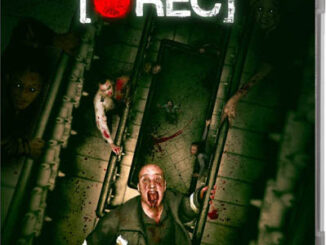
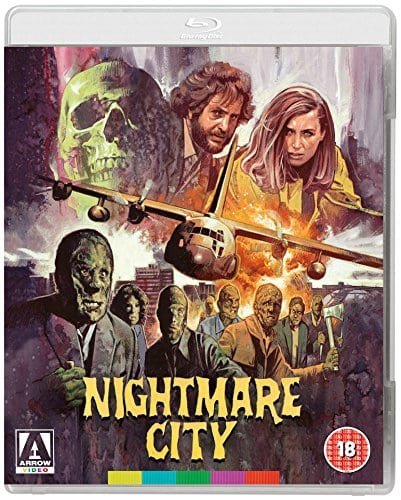

Be the first to comment